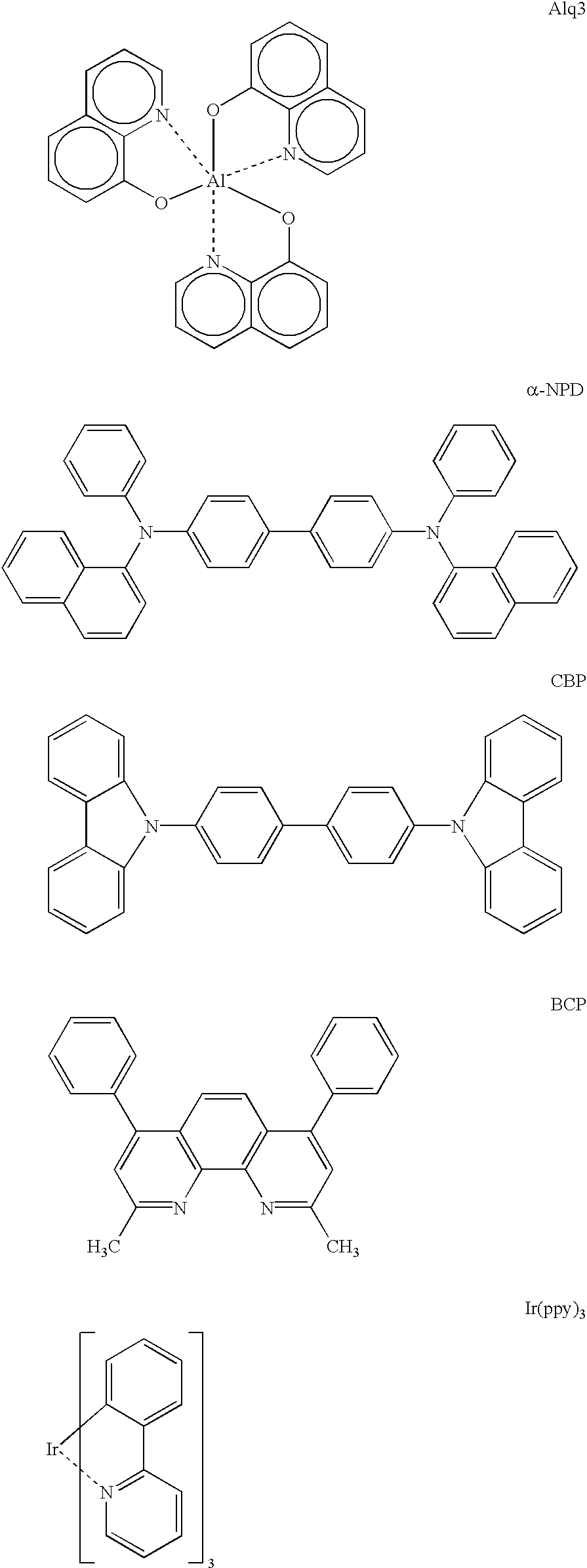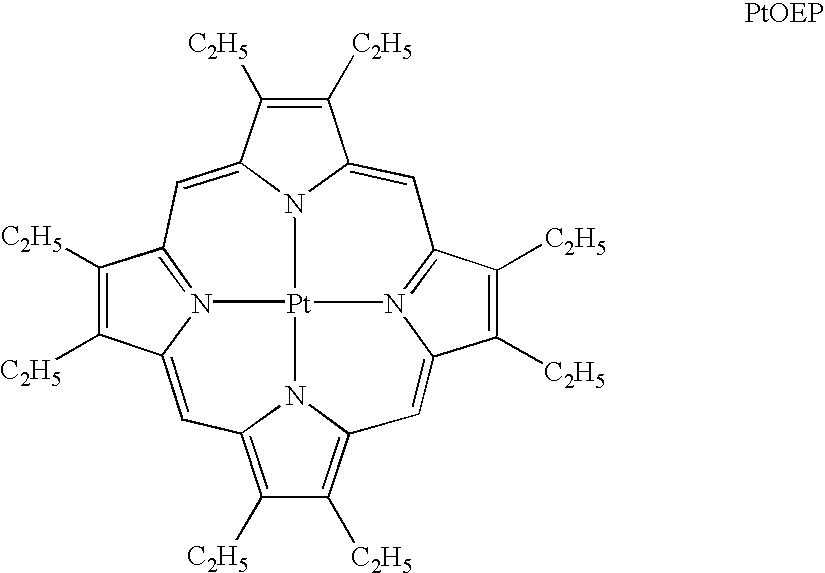Metal coordination compound and organic luminescence device
a technology of metal coordination compound and luminescence device, which is applied in the direction of mercury organic compound, organic compound of platinum group, electric lighting source, etc., can solve the problems of lowering the resultant luminescence efficiency, allowing control of emission wavelength, and not proposing phosphorescent material providing high phosphorescence yield and emission wavelength control
- Summary
- Abstract
- Description
- Claims
- Application Information
AI Technical Summary
Problems solved by technology
Method used
Image
Examples
example 2
An organic luminescence device was prepared and evaluated in the same manner as in Example 1 except for using the following metal coordination compound (Ex. Comp. No. 46) shown below in place of the metal coordination compound (Ex. Comp. No. 1). ##STR14##
As a result when a voltage of 12 volts was applied to the organic luminescence device, good luminescence resulting from the luminescence material (the metal coordination compound (Ex. Comp. No. 46) was confirmed.
When the organic luminescence device was continuously driven for 150 hours, the organic luminescence device produced stable luminescence.
example 3
A simple matrix-type organic luminescence device having a structure shown in FIG. 2 was prepared in the following manner.
On a glass substrate 21 measuring 75 mm-length, 75 mm-width and 1.1 mm-thickness, a ca. 100 nm-thick ITO film was formed by sputtering and patterned into 100 lines of 100 .mu.m-wide transparent matrix electrodes (anode side) with a spacing of 40 .mu.m as simple matrix electrodes. Then, a four-layered organic compound layer 23 was formed thereon including a luminescence layer 12 containing the metal coordination compound (Ex. Comp. No. 1) in the same manner as in Example 1.
Then, 100 lines of 100 .mu.m-wide metal electrodes 24 were formed with a spacing of 40 .mu.m by mask vacuum deposition so as to be perpendicular to the transparent electrodes by vacuum deposition at a vacuum of 2.7.times.10.sup.-3 Pa (2.times.10.sup.-5 Torr). The metal electrodes were formed as a lamination of 10 nm-thick layer of Al / Li alloy (Li: 1.3 wt. %) and then 150 nm-thick layer of Al.
The ...
example 4
Synthesis of Ex. Comp. No. 46
##STR15##
In a 1 L (litter)-three-necked flask, 10.00 g (60.3 mmol) of 1,4-phenylenebisboronic acid, 19.1 g (121 mmol) of 1-bromopyridine, 120 ml of toluene, 60 ml of ethanol and 25 ml of 2M-sodium carbonate aqueous solution, were placed and stirred at room temperature under a nitrogen stream, followed by addition of 4.74 g (4.10 mmol) of tetrakis(triphenylphosphine)palladium (0). Thereafter, the system was refluxed under stirring and nitrogen stream for 8 hours. After completion of the reaction, the reaction product was cooled and extracted by adding cold water and toluene. The organic layer was washed with saline water and dried with anhydrous magnesium sulfate, followed by removal of the solvent under a reduced pressure to provide dry solid. The residue was purified by silica gel column chromatography (eluent: toluene / ethyl acetate=2 / 1) to obtain 7.8 g (yield=56%) of 1,4-bis(2-pyridyl)benzene. ##STR16##
In a 10 L-three-necked flask, 50.0 g (142 mmol) of...
PUM
| Property | Measurement | Unit |
|---|---|---|
| thickness | aaaaa | aaaaa |
| triplet energy level | aaaaa | aaaaa |
| luminescence area | aaaaa | aaaaa |
Abstract
Description
Claims
Application Information
 Login to View More
Login to View More - R&D
- Intellectual Property
- Life Sciences
- Materials
- Tech Scout
- Unparalleled Data Quality
- Higher Quality Content
- 60% Fewer Hallucinations
Browse by: Latest US Patents, China's latest patents, Technical Efficacy Thesaurus, Application Domain, Technology Topic, Popular Technical Reports.
© 2025 PatSnap. All rights reserved.Legal|Privacy policy|Modern Slavery Act Transparency Statement|Sitemap|About US| Contact US: help@patsnap.com



